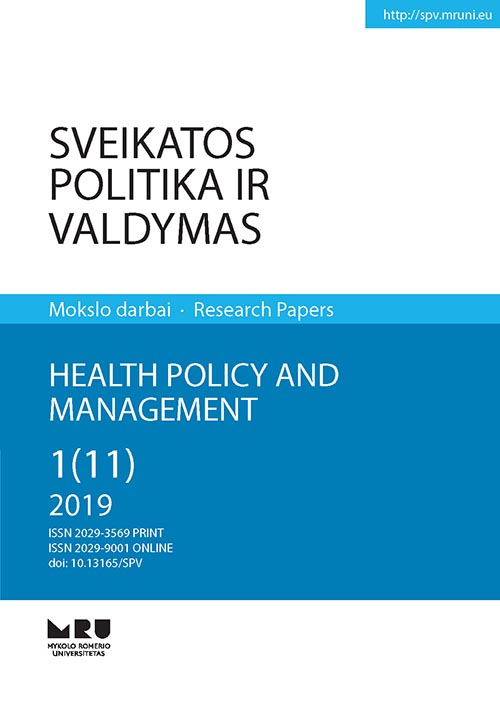MANAGEMENT OF ADVERSE EVENTS IN THE HOSPITAL
##plugins.themes.bootstrap3.article.main##
Abstract
The goal of every health care institution (HCI) is to provide safe and highquality services to patients, but sometimes the provision of health care (HC) services result in unavoidable adverse events (AE). AE can harm and cause irreversible health problems to the patient, so patient safety and AE remain a global concern worldwide.
Recently there has been a growing number of researches both locally and worldwide on how to ensure patient safety (PS), how to deliver quality services in HC sector, and how to reduce the number of AE. Council of Europe has issued recommendations on how to improve HC services, but according to the results of the survey conducted in 2014, AE remain a big problem in EU countries. Later in 2017, it has been noted that the recommendations were insufficiently implemented at a national level. The European Commission has pointed out some shortcomings: lack of cooperation between EU countries, deficiencies in safety culture implementation, lack of knowledge and skills in analyzing AE.
This article analyzes the success of AE policy implementation in Lithuania, why Lithuania and the EU countries have created a mandatory AE register, but the registration of these events is slow, most of them are still unreported, their real number and frequency are still hidden, and their causes are not analyzed. Based on a case study and qualitative study in one large hospital, attempts are made to identify the factors of AE management that constitute a barrier to effective AE management policy in healthcare institutions.
Prerequisites for successful AE management consist of electronisation of AE reporting system, development and control of quality standards, strategic, continuous and ongoing leadership of HC administration and staff involvement and their motivation, also adjusted training, creating organizational culture of confidentiality and learning from mistakes. Some shortcomings were also noted: lack of knowledge and skills, overcoming fears of being punished and humiliated, lack of feedback, lack of national AE IT system. This limits the efficiency of the AE management process both nationally and locally. Successful choice of AE management model directly depends on the internal policies, operations, and leadership of HC institution. Well-planned, organized and controlled measures, based on European recommendations, help to achieve the objectives by monitoring and evaluating their results in a consistent and long-term manner. It is confirmed, that AE registration and continuous analysis is key to prevent future AE. Therefore, the basis of EU countries’ AE management policy is choosing the right AE management model according to the maturity of the system, which includes the implementation of the reporting system in HC institutions and, most importantly, the analysis and development of prevention actions. This helps to share experience, constantly analyze, learn from mistakes, and shape a new approach and PS culture.
Recently there has been a growing number of researches both locally and worldwide on how to ensure patient safety (PS), how to deliver quality services in HC sector, and how to reduce the number of AE. Council of Europe has issued recommendations on how to improve HC services, but according to the results of the survey conducted in 2014, AE remain a big problem in EU countries. Later in 2017, it has been noted that the recommendations were insufficiently implemented at a national level. The European Commission has pointed out some shortcomings: lack of cooperation between EU countries, deficiencies in safety culture implementation, lack of knowledge and skills in analyzing AE.
This article analyzes the success of AE policy implementation in Lithuania, why Lithuania and the EU countries have created a mandatory AE register, but the registration of these events is slow, most of them are still unreported, their real number and frequency are still hidden, and their causes are not analyzed. Based on a case study and qualitative study in one large hospital, attempts are made to identify the factors of AE management that constitute a barrier to effective AE management policy in healthcare institutions.
Prerequisites for successful AE management consist of electronisation of AE reporting system, development and control of quality standards, strategic, continuous and ongoing leadership of HC administration and staff involvement and their motivation, also adjusted training, creating organizational culture of confidentiality and learning from mistakes. Some shortcomings were also noted: lack of knowledge and skills, overcoming fears of being punished and humiliated, lack of feedback, lack of national AE IT system. This limits the efficiency of the AE management process both nationally and locally. Successful choice of AE management model directly depends on the internal policies, operations, and leadership of HC institution. Well-planned, organized and controlled measures, based on European recommendations, help to achieve the objectives by monitoring and evaluating their results in a consistent and long-term manner. It is confirmed, that AE registration and continuous analysis is key to prevent future AE. Therefore, the basis of EU countries’ AE management policy is choosing the right AE management model according to the maturity of the system, which includes the implementation of the reporting system in HC institutions and, most importantly, the analysis and development of prevention actions. This helps to share experience, constantly analyze, learn from mistakes, and shape a new approach and PS culture.
##plugins.themes.bootstrap3.article.details##
Section
Articles
Authors contributing to Health policy and management agree to publish their articles under a Creative Commons Attribution-NoDerivatives 4.0 International Public (CC BY-NC-ND) License, allowing third parties to share their work (copy, distribute, transmit) and to adapt it, under the condition that the authors are given credit, and that in the event of reuse or distribution, the terms of this licence are made clear.








